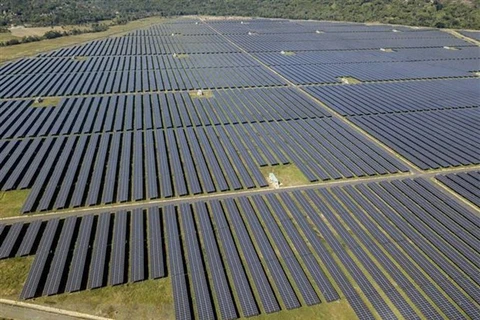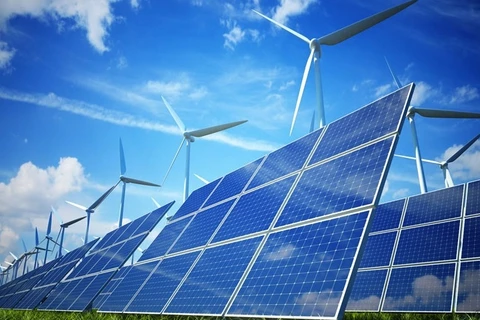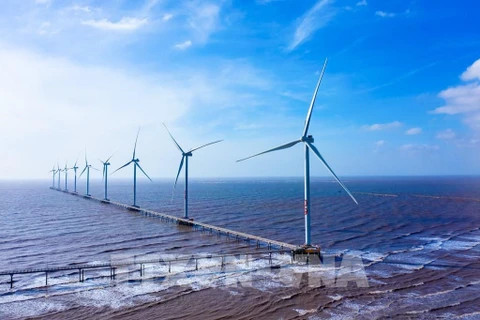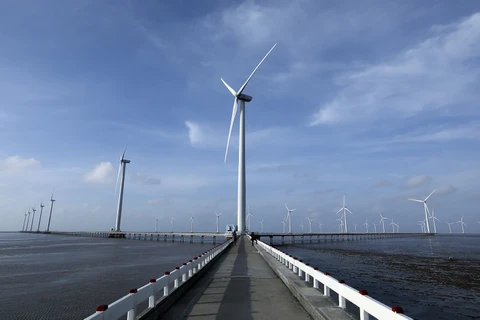 Photo: Workshop discusses impacts of COP26 on energy transition towards green growth. (Photo: VietnamPlus)
Photo: Workshop discusses impacts of COP26 on energy transition towards green growth. (Photo: VietnamPlus) Hanoi (VNA) - Building an appropriate and sustainable energy transition and development strategy following the country's conditions is Vietnam's most important green growth task, said Deputy Minister of Industry and Trade Dang Hoang An.
Vietnam will develop gas-fired power plants using imported LNG at an appropriate scale; promote the development of renewable energy sources at reasonable prices in association with ensuring electricity system’s operation safety.
This information was given at a conference on the impact of COP26 on the energy transition towards green growth, held by the Ministry of Industry and Trade (MoIT) on August 17 in Hanoi.
Minimising coal thermal power
A representative of the MoIT said that Vietnam had experienced more than 20 consecutive years with an annual economic growth rate of 5.9-7%, including the world economic downturn period from 2006 – 2010 and the global financial crisis in 2008.
The annual electricity demand in Vietnam during this period was at double digits, usually from 1.5-1.8 times the GDP growth rate, expanding by 13% in the 2000-2010 period and 10.5% in the 2011-2019 period.
According to the Director of the MoIT's Department of Electricity and Renewable Energy, Hoang Tien Dung, by the end of 2020, Vietnam's total installed power capacity will reach 69,342 MW, ranking 2nd among ASEAN member states and 23rd in the world.
Of which, hydropower reached 20,993 MW (accounting for 30.3% of the capacity and 29.6% of the output); coal-fired power (21,383 MW); gas turbines (9,025 MW); and solar power (16.506 MW).
Specifically, hydroelectricity reached 20,993 MW (accounting for 30.3% of capacity and 29.6% of output); coal-fired power, 21,383 MW (30.8% capacity, 50% output); gas-fueled power, 9,025 MW (13.1% of capacity, 14.6% of output); and solar power, 16,506 MW (23.8% of capacity, 3.7% of output).
Thermal power is the main source of electricity for Vietnam's grid, especially coal-fueled power, which accounts for more than 31% of capacity and up to 50% of output.
Before COP26, on October 8, 2021, the National Power Development Plan for the 2021 - 2030 period, with a vision towards 2045 (PDP VIII), was submitted to the Prime Minister for approval.
Accordingly, the electricity production structure by 2045 will include hydropower, 8.2-9.8%, coal-fired thermal power, 27.4-32.4%; gas-fired thermal power, 28.4-33.1%; and renewable energy other than hydroelectricity, 26.5-28.4%.
Dung said thermal power sources by 2045 in the Master Plan submitted before COP26 still account for a relatively high proportion, between 36% - 41% of the capacity and 56% - 66% of the output. This is the main cause of high CO2 emissions.
CO2 emissions from electricity generation will increase rapidly, reaching about 245 million metric tonnes by 2030 and about 383 million tonnes by 2045.
However, Vietnam's carbon-neutral commitments by 2050 made by the Prime Minister at COP26 have completely changed Vietnam's electricity development perspective in the coming time. Therefore the PDP VIII had to be recalibrated entirely, Dung said.
Green growth: opportunities and inevitable choices
Lessons on the economic growth of many countries worldwide show that the development of science and technology has created many major breakthroughs but has not yet led to sustainability. The most obvious proof is that the large-scale exploitation of natural resources has caused many negative impacts on the environment, biodiversity loss, and global climate change.
With its rapidly growing economy, Vietnam boasts many opportunities but also faces difficulties and challenges in ensuring energy security and green and sustainable development when the demand for electricity and energy continues to grow rapidly along with the industrialisation and modernisation of the country.
According to Deputy Minister of Industry and Trade Dang Hoang An, building an appropriate and sustainable energy transition and development strategy following the actual condition of the country is the most important task of Vietnam to ensure national energy security to meet development goals and ensure access to energy for people and the economy at reasonable costs./.
























